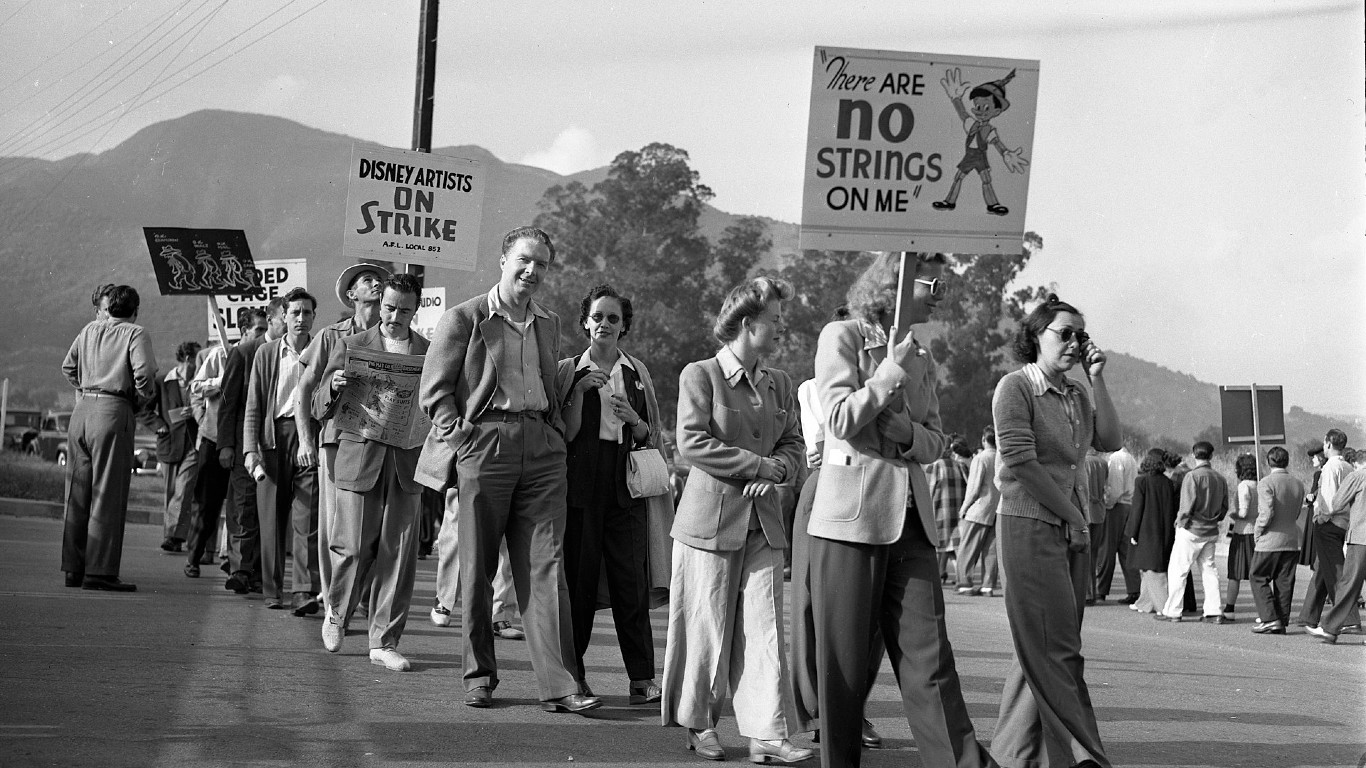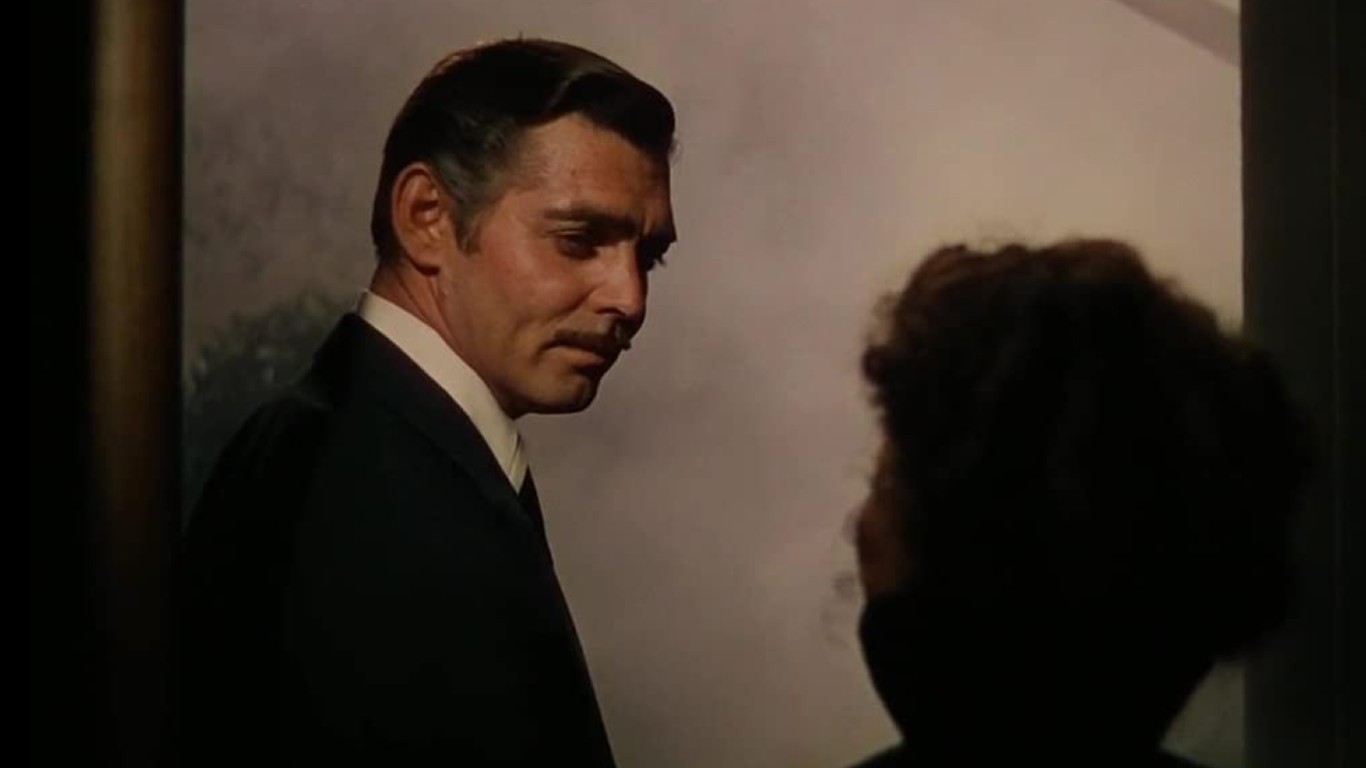
The Writers Guild of America – which represents writers who work in film, television, radio, and online media – went on strike in early May, affecting dozens of television and film productions. Some of those with completed scripts initially continued filming but were forced to shut down as crew members refused to cross WGA picket lines or their showrunners suspended production in solidarity.
A little more than two months later, the joint Screen Actors Guild and American Federation of Television and Radio Artists also went on strike, virtually paralyzing the entertainment industry. Both unions are pushing for higher residual earnings, as the age of streamed content has reduced royalties to a trickle. The unions also seek protections against artificial intelligence replacing humans in these creative fields. (Here are 20 jobs vulnerable to automation and AI takeover.)
This isn’t the first time Hollywood has been shut down as a result of trade union strikes. When contract negotiations fail, the majority of union members often vote to authorize a walkout. To assemble a list of some of the most important strikes in Hollywood history, 24/7 Tempo referred to sources including the websites of SAG-AFTRA and the WGA, the New York Times, and the Journal of the University Film Association.
Click here to read about 19 of the most significant strikes in Hollywood history
In the 20th century, there was fierce rivalry between various Hollywood unions and union federations, sometimes involving political pressures, police actions, and the interference of both organized crime and the Communist Party. Some of these labor organizations have long since disappeared, while others have consolidated their power and influence.
Today, union representation has been regularized for the most part and strikes typically pit one or more unions against the Alliance of Motion Picture and Television Producers – a trade association representing over 350 film and television production companies. (These are 31 of the largest worker strikes in American history.)
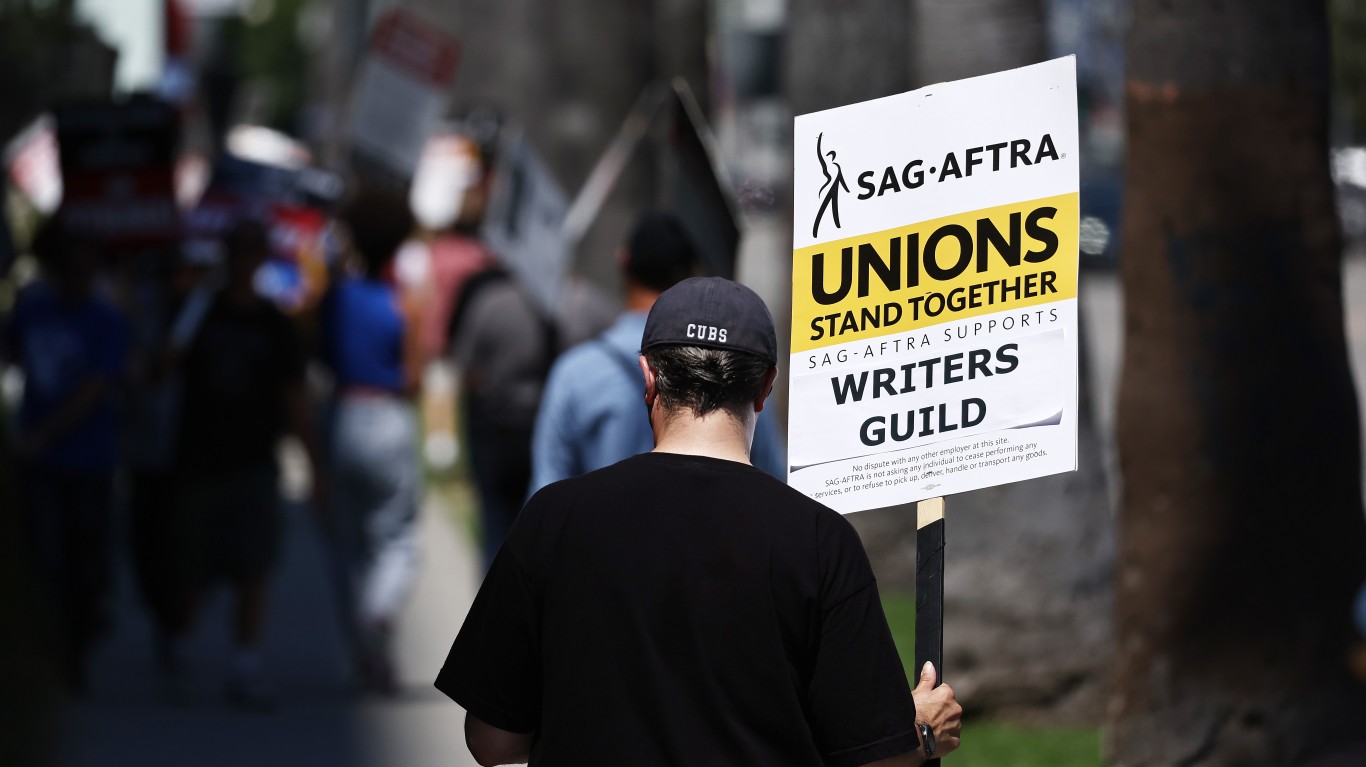
SAG-AFTRA strike
> Duration: Ongoing
> Timeline: July 14, 2023-present
The current strike by the Screen Actors Guild and the American Federation of Television and Radio Artists (the two formerly separate unions merged on March 30, 2012) against the Alliance of Motion Picture and Television Producers is focused not only on increasing minimum pay rates and ensuring that actors’ likenesses are not replaced by AI replications without proper compensation, but also a host of other demands, including 2% of the revenues generated by streamed content and a limit on self-taped auditions, which have shifted the burden of auditioning to the actor rather than the production studios during the post-COVID era.
[in-text-ad]

Writers Guild of America strike
> Duration: Ongoing
> Timeline: May 2, 2023-present
As royalties in the streaming age have dwindled and Artificial Intelligence threatens to take work from writers, the WGA is currently on strike against the AMPTP. Among the Guild’s demands are increased compensation and residual payments, increased employer contributions to pension and healthcare plans, and the guarantee that AI can only be used as a research tool and not a replacement for human writers.
WGA strike
> Duration: 3 months, 7 days
> Timeline: Nov. 5, 2007-Feb. 12, 2008
In this WGA strike. writers sought fair compensation for digital media use of their work, as well as DVD residuals and jurisdiction over reality and animated program writing. The strike concluded in early 2008 after a compromise was reached, providing writers a percentage of revenue from digital distribution, with no change to the DVD residuals or jurisdictional issues.
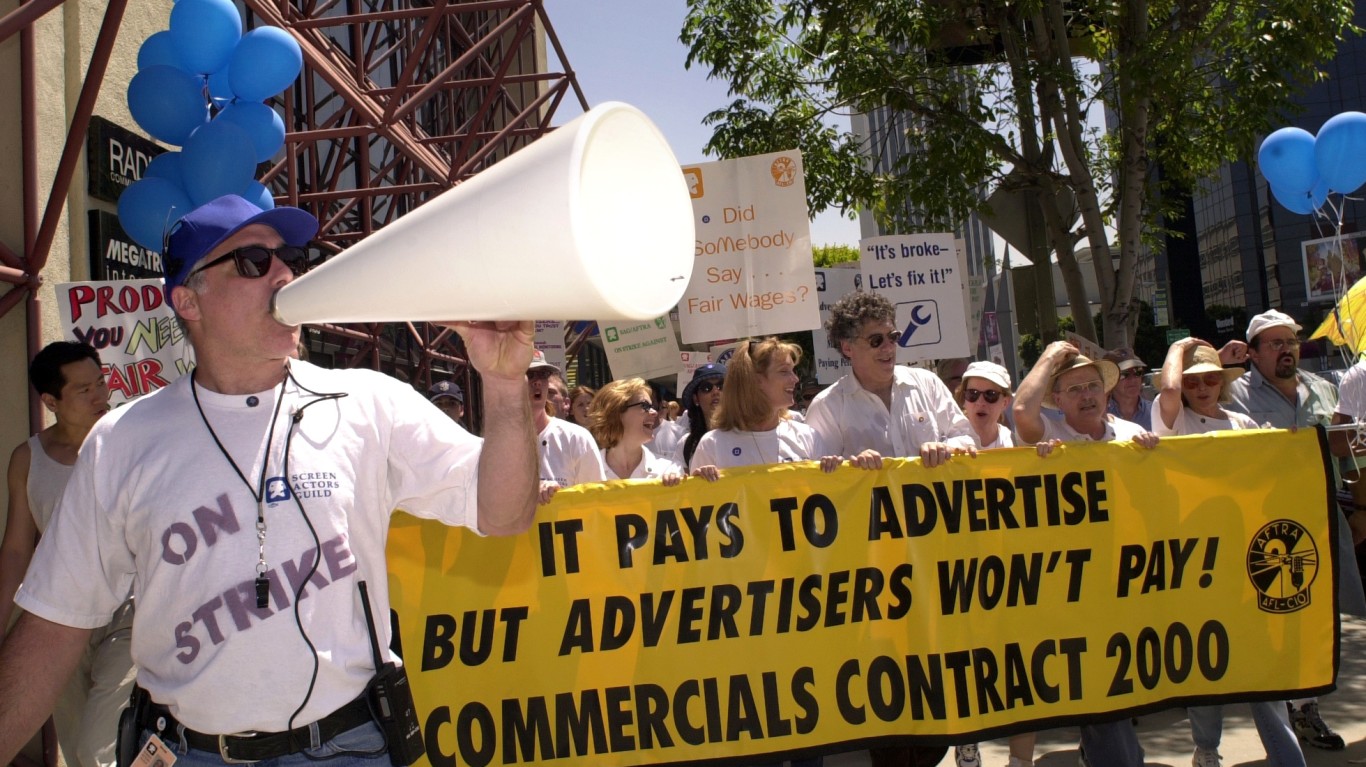
SAG and AFTRA commercials strike
> Duration: 5 months, 29 days
> Timeline: May 1-Oct. 30, 2000
SAG and AFTRA, at the time still separate unions, initiated this strike over disputes regarding pay for commercials on cable television and advertisements on the internet. This strike ranks among the top 10 largest strikes in U.S. history. It concluded with a three-year deal that improved contract pay scales but didn’t fully address the contentious issue of residuals for cable and internet ads.
[in-text-ad-2]
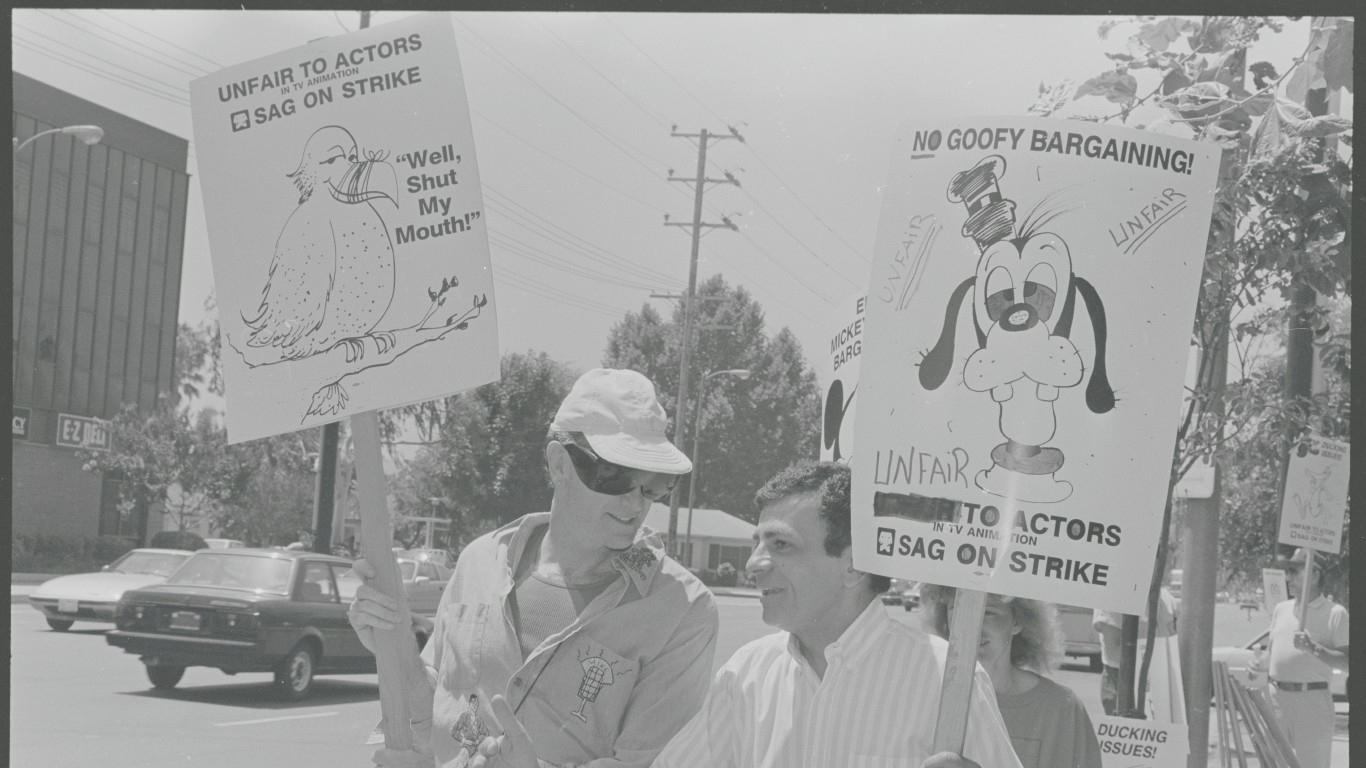
SAG and AFTRA TV commercials strike
> Duration: 25 days
> Timeline: March 21-April 15, 1988
This strike by the two performers’ unions was triggered by disagreements with the advertising industry over residual earnings for actors in cable TV commercials, as well as a push for cost of living adjustments. The conflict concluded with a settlement ensuring commercial actors would receive 10% higher session fees and 10% higher residuals.
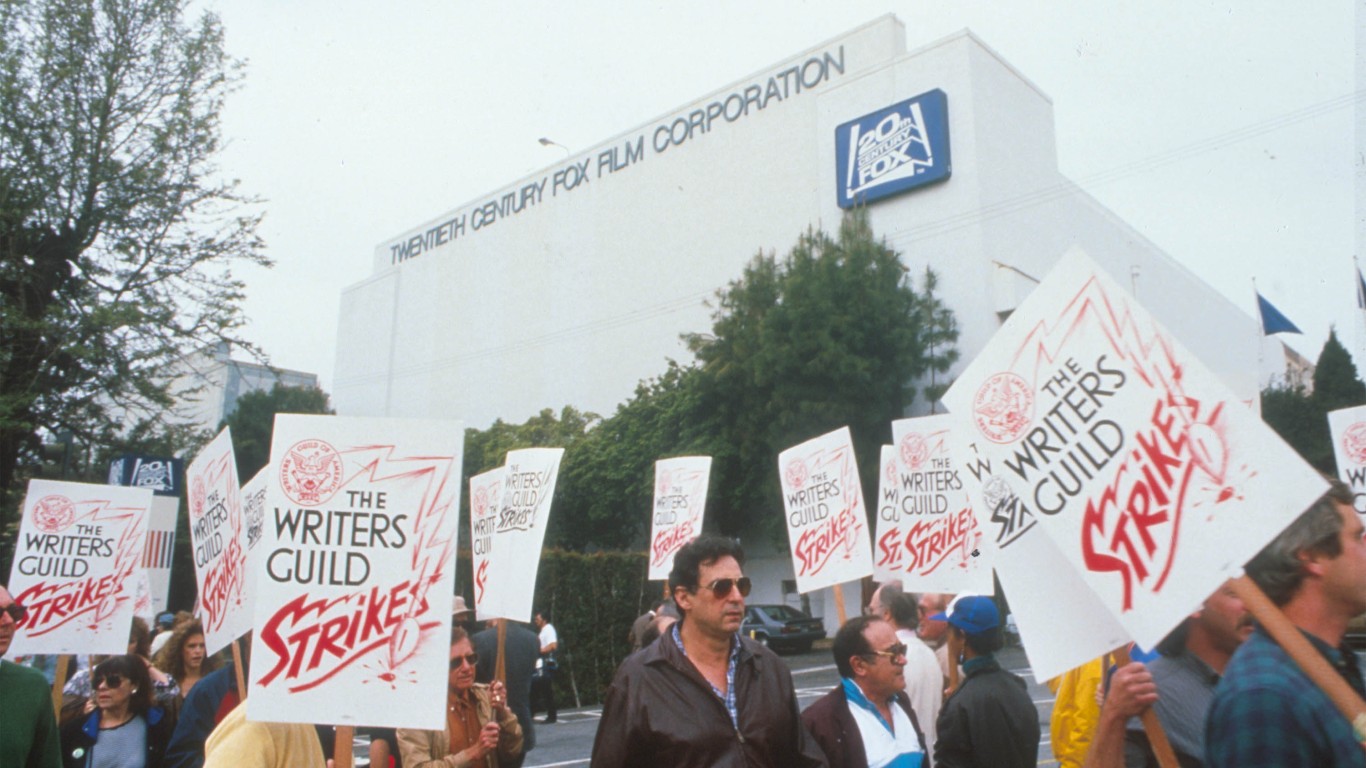
WGA strike
> Duration: 5 months, 1 day
> Timeline: March 7-Aug. 8, 1988
The longest strike in WGA history, this labor action was spurred by disputes over residual payments for reruns and the sale of programs to foreign markets. The guild turned down a settlement offer in June, and the strike finally ended in August with agreement on a three-year contract, which included increased payments for reruns – though it fell far short of the WGA’s initial demands regarding programs broadcast overseas. The 22-week strike reportedly cost the industry around $500 million.
[in-text-ad]

Directors Guild of America strike
> Duration: 3 hours, 5 minutes
> Timeline: July 14, 1987
The shortest of all Hollywood strikes was the 1987 DGA walkout, which briefly halted production after pressure from NBC and two major studios to roll back minimum residual compensation for directors. In the end, the Guild prevailed and was able to secure three-year freelance contracts in film and television.

WGA strike
> Duration: 2 weeks
> Timeline: March 6-20, 1985
The 1985 WGA strike started after disagreements over home video royalties. The Guild, which already saw shares of producer profits from the home video market, demanded a cut of distributor profits as well. After intense negotiations, the Guild dropped its demands and accepted a 6% increase in wages and additional health benefits.
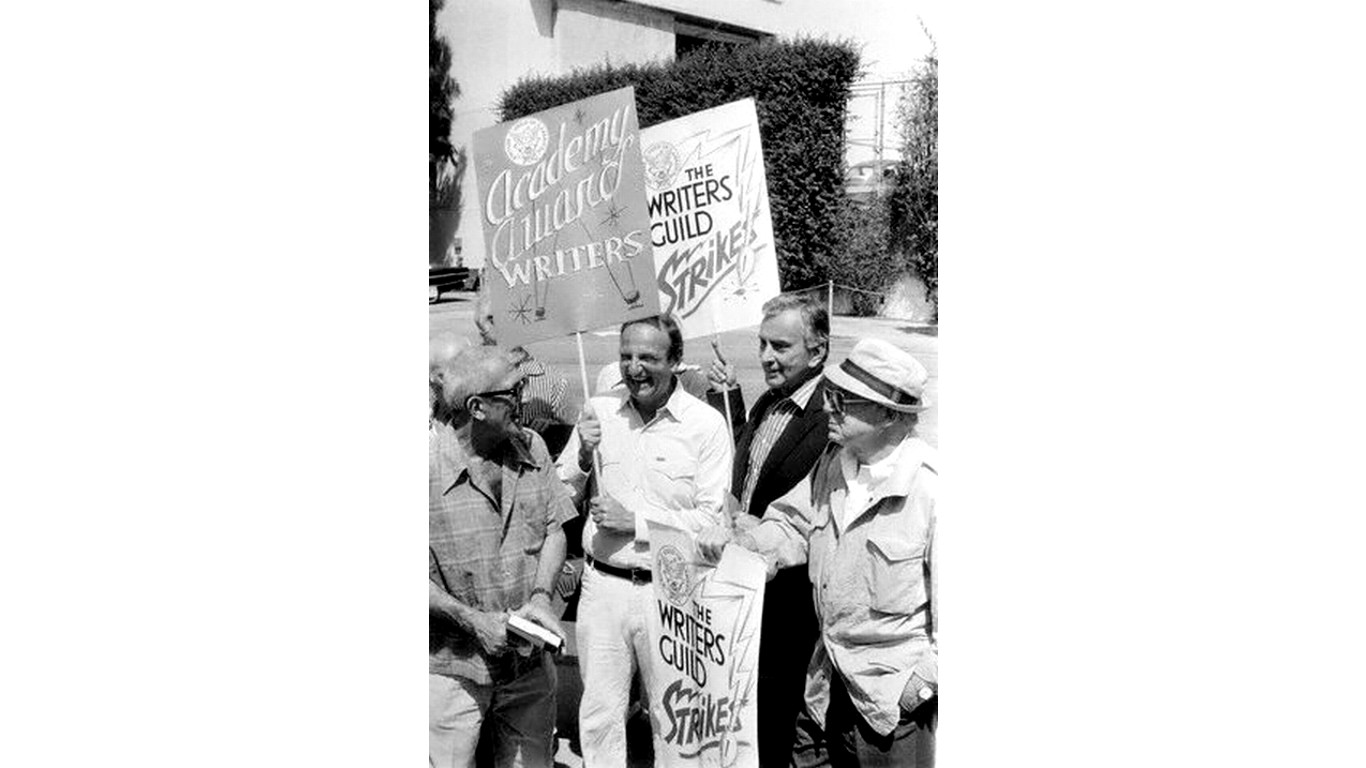
WGA strike
> Duration: 3 months, 1 day
> Timeline: April 11-July 12, 1981
The WGA strike of 1981, initiated over disputes about home video, cable, and pay TV profits, aimed to secure a greater share of these revenues for writers. The strike concluded with an agreement that increased the writers’ share of home video revenue, though less than initially demanded, and granted a fixed percentage of gross earnings from reruns.
[in-text-ad-2]
SAG and AFTRA strike
> Duration: 3 months, 3 days
> Timeline: July 21-Oct. 24, 1980
The 1980 actors’ strike was triggered by disputes over home video and paid TV residuals. The strikers aimed to secure a higher percentage of profits from these emerging markets, as well as 35% salary increases. The industry was paralyzed and the 32nd Emmy Awards were boycotted. The strike concluded with a deal granting actors a 4.5% share of home video revenues – less than they had hoped for – as well as 32.5 % wage increases, 30% residuals increases, and additional healthcare, pension, and overtime benefits.
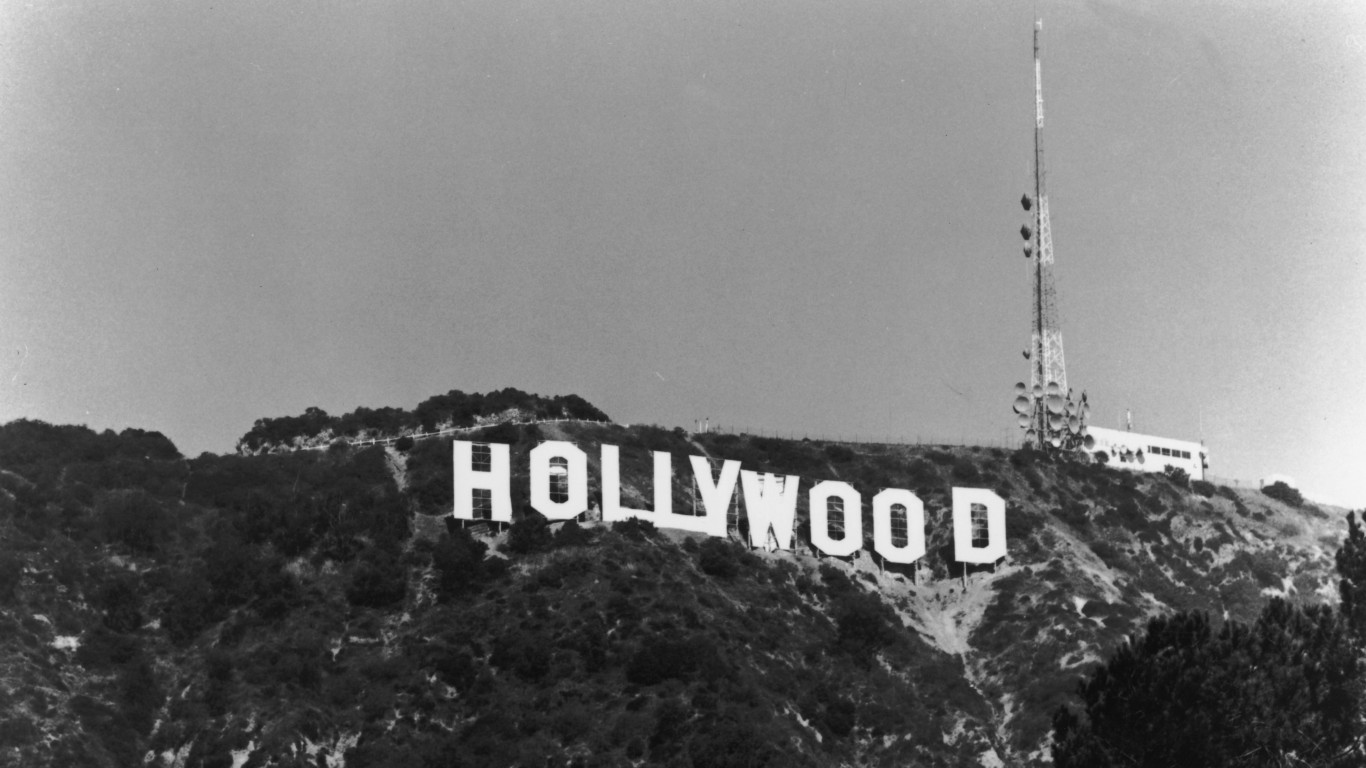
SAG and AFTRA commercials strike
> Duration: 1 month, 19 days
> Timeline: Dec. 19, 1978-Feb. 7, 1979
Rallying against advertising agencies for better residuals from radio and television ads, SAG and AFTRA both went on strike in late 1978, causing an 80% decrease in the production of commercials. The strike settlement included significant wage increases for actors, including a 15% increase in session fees to $250, and quashed ad agencies’ plans to use non-union actors for commercials.
[in-text-ad]

WGA screenwriters strike
> Duration: 3 months, 24 days
> Timeline: March 6-June 30, 1973
As home video technology advanced, WGA screenwriters initiated a strike against the AMPTP to ensure compensation for the sale of video cassettes. The union won residuals for home video sales as well as pay TV and cable TV, and also scored incremental salary increases for writers on long projects, increased health care benefits, and protections for “hyphenates” (writer-producers, writer-directors, etc).

AFTRA strike
> Duration: 13 days
> Timeline: March 29-April 10, 1967
The AFTRA strike in 1967 was the union’s first nationwide strike, and although it concerned contract salaries for broadcast journalists on network news and radio shows, all 18,000 union members participated. News anchor Walter Cronkite refused to cross the picket line, leaving a CBS producer to run the evening news. The resolution – which established the first contracts for network correspondents at CBS, NBC, and ABC – came just in time for the Academy Awards to go on without delay.

WGA strike
> Duration: 4 months, 27 days
> Timeline: Jan. 16-June 12, 1960
The WGA strike of 1960 was a labor dispute initiated by writers demanding increased wages, employment benefits, and residuals for projects aired on television. The strike ended when the studios agreed to grant residual payments for televised productions and begin offering health benefits and pensions for script writers.
[in-text-ad-2]
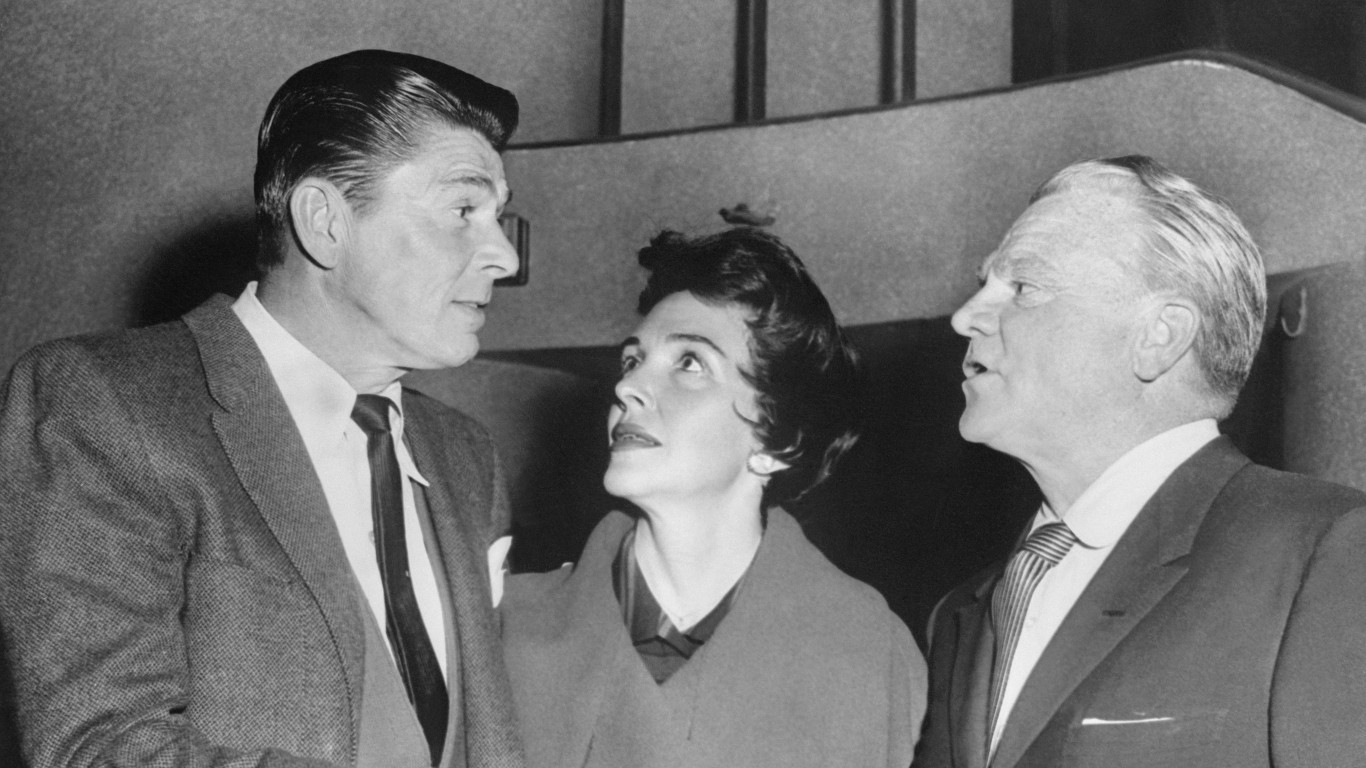
SAG strike
> Duration: 1 month, 11 days
> Timeline: March 7-April 18, 1960
The actors’ strike of 1960, spearheaded by SAG’s 13,680 members under the leadership of Guild president Ronald Reagan, arose due to disagreements over residual payments for films shown on television. The resolution came with a deal that granted actors a percentage of the profits from televised films produced in 1960 and after, and a lump sum of $2.65 million (about $27.4 million in today’s dollars) that SAG used to start a pension and health plan for members.
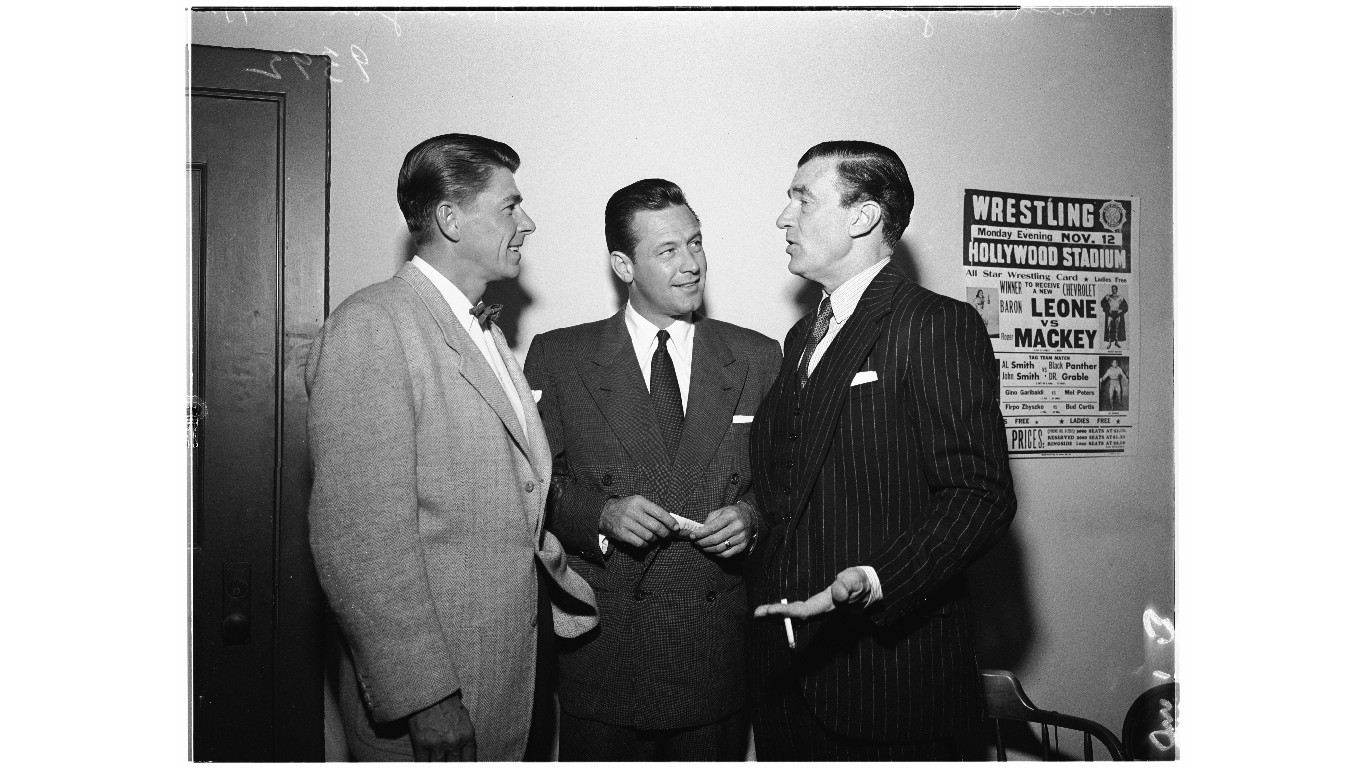
Commercial actors’ strike
> Duration: 2 months, 17 days
> Timeline: Dec. 1, 1952-Feb. 18, 1953
The first strike initiated by SAG, this strike centered around compensation, residuals, and working conditions for actors working in commercials. It ended with a contract in which the AMPTP recognized SAG as a bargaining agent for performers in commercials.
[in-text-ad]
Conference of Studio Unions “Hollywood Black Friday” strike
> Duration: 7 months, 12 days
> Timeline: March 12, 1945-Oct. 24, 1945
The CSU, which represented workers in numerous film industry unions – including carpenters, painters, electricians, and cartoonists, as well as set decorators – went on strike after 77 set decorators joined it, defecting from a rival union, the International Alliance of Theatrical Stage Employees. IATSE maintained that the CSU had no jurisdiction over those workers, but the War Labor Board upheld the CSU’s claim. When producers refused to honor the decision, a strike was called. The prolonged conflict culminated in a bloody riot on Oct. 5 – dubbed Black Friday by labor historians – outside of Warner Bros. studios. IATSE eventually won out, and the greatly diminished CSU faded away. The conflict was partially responsible for the passing of the Taft-Hartley Act of 1947, which greatly restricted the power of labor unions.
Disney animators’ strike
> Duration: 3 months, 26 days
> Timeline: May 29-Sept. 21, 1941
The strike by Disney animators was caused by disparities in pay and recognition among the Disney Studios non-unionized employees, who were seeking improved salaries and working conditions and union recognition. Walt Disney himself personally fired a number of the strikers, but the studio was eventually forced to accept the Screen Cartoonists Guild as the employees’ representative, and hire back those animators who wished to return.

Federated Motion Picture Crafts strike
> Duration: 2 months, 10 days
> Timeline: April 30-July 10, 1937
The newly formed Federated Motion Picture Crafts union, which represented draftsmen, painters, scenic artists, make-up artists, and hairdressers, went on strike against nine major Hollywood studios, demanding recognition of the FMPC, unionization of its members, new contracts, and increased wages. There was violence on the picket lines, including battles between longshoremen who supported the FMPC and thugs from Chicago brought in by the union’s rival, IATSE, but on July 10, the workers voted to accept an offer from producers which gave them new contracts but dissolved the FMPC.
It’s Your Money, Your Future—Own It (sponsor)
Are you ahead, or behind on retirement? For families with more than $500,000 saved for retirement, finding a financial advisor who puts your interest first can be the difference, and today it’s easier than ever. SmartAsset’s free tool matches you with up to three fiduciary financial advisors who serve your area in minutes. Each advisor has been carefully vetted and must act in your best interests. Start your search now.
If you’ve saved and built a substantial nest egg for you and your family, don’t delay; get started right here and help your retirement dreams become a retirement reality.
Thank you for reading! Have some feedback for us?
Contact the 24/7 Wall St. editorial team.


 24/7 Wall St.
24/7 Wall St.
